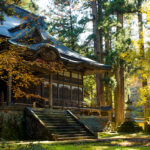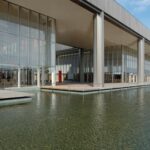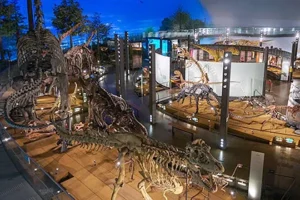 Tucked away in the green hills of Katsuyama City, Fukui Prefectural Dinosaur Museum is one of the world’s leading dinosaur museums and Japan’s undisputed “Dinosaur Kingdom.”
Tucked away in the green hills of Katsuyama City, Fukui Prefectural Dinosaur Museum is one of the world’s leading dinosaur museums and Japan’s undisputed “Dinosaur Kingdom.”
With its world-class exhibits, life-sized reconstructions, and real fossil excavation sites nearby, the museum offers an extraordinary journey back to the prehistoric age — making it a must-visit destination for families, science enthusiasts, and travelers of all ages.
Opened in 2000, the museum sits within the Dinosaur Valley Fukui Katsuyama Geopark, where some of Japan’s most important dinosaur fossils have been unearthed.
It’s not only a museum but also an active research center where paleontologists continue to discover new species that have reshaped our understanding of Asia’s dinosaur history.
Contents
Overview

The Fukui Prefectural Dinosaur Museum (FPDM) is Japan’s largest natural history museum dedicated to dinosaurs.
It houses over 44,000 specimens, including fossils, skeletons, life-sized animatronic models, and interactive scientific exhibits.
Its futuristic silver dome stands out against the surrounding mountains, symbolizing a time capsule between past and present — a gateway to the world of the Mesozoic era.
Architectural Highlights
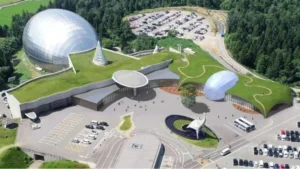
The museum’s building, designed by renowned architect Kishō Kurokawa, features a silver dome 86 meters wide and 37 meters tall, inspired by the image of an ancient egg or a meteorite.
Inside, the massive spiral ramp takes visitors gradually downward, symbolizing a journey back in time to the age of the dinosaurs.
The sleek, metallic exterior contrasts beautifully with the lush natural scenery, while the vast open interior creates a sense of awe fitting for the creatures it celebrates.
Main Exhibition Zones
The museum’s 4,500-square-meter exhibition space is divided into four major zones, connected by a continuous walkway that guides visitors through time.
1. Dinosaur World (恐竜の世界)
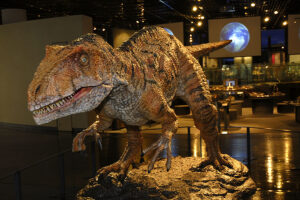
The most popular and breathtaking section — an enormous hall filled with life-sized dinosaur skeletons and realistic animatronic models that roar, move, and breathe.
Highlights include:
-
Fukuiraptor kitadaniensis and Fukuisaurus tetoriensis, two dinosaur species discovered right in Fukui Prefecture.
-
A Tyrannosaurus rex animatronic towering over visitors.
-
Dozens of skeletons from North America, China, and Mongolia.
-
A “dinosaur parade” display that recreates the ancient ecosystem in dynamic motion.
Dim lighting, ambient sounds, and dramatic spotlights make the experience deeply immersive — like walking into a real Jurassic world.
2. Earth Sciences (地球の科学)
This zone explores the formation and evolution of Earth, from volcanic activity to plate tectonics and ancient life.
You can see meteorites, minerals, and fossils showing the history of life over billions of years.
Interactive displays allow you to touch rocks and observe how Earth’s surface changed through time.
3. Life Sciences (生命の科学)
Focuses on the biology and anatomy of dinosaurs and their connection to modern animals.
Skeleton comparisons between birds, reptiles, and dinosaurs help explain evolution and adaptation.
Children can learn through hands-on experiments about how fossils form or how paleontologists reconstruct ancient creatures.
4. Dino Lab (ディノラボ)
A favorite for families — this laboratory-like space lets visitors touch real fossils, use magnifying glasses, and try “mini excavation” experiences.
Some programs are supervised by museum researchers, offering an authentic taste of paleontology.
Special Exhibitions and Research
In addition to its permanent displays, FPDM hosts seasonal special exhibitions showcasing new discoveries, international fossil collections, and traveling displays from other major museums.
The museum is also the headquarters for Japan’s dinosaur research, housing laboratories where paleontologists study and name new species — such as:
-
Fukuititan nipponensis (2010)
-
Fukuiraptor kitadaniensis (2000)
-
Koshisaurus katsuyama (2015)
Many of these dinosaurs were excavated from the nearby Kitadani Dinosaur Quarry, one of Asia’s richest fossil sites.
Dinosaur Excavation Experience
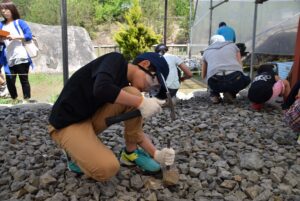
Just 3 kilometers from the museum, the Dinosaur Quarry Field Station offers a unique hands-on excavation experience.
Visitors can dig for fossils using real tools under the guidance of researchers.
You may not find a full skeleton, but it’s common to discover small bone fragments, ancient plant fossils, or shells — and the thrill of finding something millions of years old is unforgettable.
Advance reservation is required, especially during weekends and holidays.
Museum Shop and Restaurants
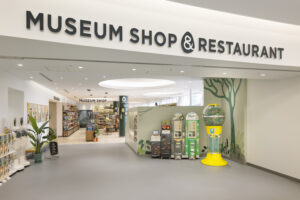
-
Museum Shop: Sells dinosaur-themed souvenirs, toys, books, and even local sweets shaped like fossils.
-
Restaurant “Dino”: Serves casual meals such as curry, pasta, and soft-serve ice cream decorated with dinosaur motifs — perfect for families and kids.
-
Dino Café: Offers a relaxing view of the surrounding forest with coffee and light snacks.
Surrounding Attractions
The museum is part of the Katsuyama Dinosaur Forest Park, a large nature and recreation area.
Nearby attractions include:
-
Dinosaur Park Katsuyama: An outdoor park with full-scale dinosaur statues in natural forest settings.
-
Heisenji Hakusan Shrine: A mystical moss-covered shrine dating back over 1,300 years.
-
Echizen Daibutsu Temple: One of Japan’s largest seated Buddha statues.
-
Katsuyama City Center: Features charming cafes and local craft shops.
Location and Access
Address:
51-11 Terao, Muroko-cho, Katsuyama City, Fukui Prefecture 911-8601, Japan
Access:
-
By Train:
Take the Echizen Railway Katsuyama Line from Fukui Station to Katsuyama Station (about 1 hour).
From Katsuyama Station, take a community bus or taxi (10 minutes) to the museum. -
By Car:
About 1 hour from Fukui City via the Chubu Jukan Expressway.
Free parking is available on site.
Hours and Admission
-
Open: 9:00 AM – 5:00 PM (last entry at 4:30 PM)
-
Closed: 2nd and 4th Wednesdays (and during New Year holidays)
-
Admission Fee:
-
Adults: ¥730
-
High school/university students: ¥430
-
Elementary/junior high students: ¥260
-
Free for preschoolers
-
Special exhibitions may require additional fees.
Best Time to Visit
The museum is open year-round, but the surrounding scenery changes beautifully with the seasons:
-
Spring: Cherry blossoms bloom along the nearby river.
-
Summer: Lush green forests and outdoor fossil digging experiences.
-
Autumn: Vibrant fall foliage around the museum dome.
-
Winter: Snow-covered landscapes make the silver dome look even more otherworldly.
Why You Should Visit

The Fukui Prefectural Dinosaur Museum is not just for children — it’s a destination that bridges science, imagination, and the deep history of our planet.
It combines cutting-edge research with powerful visual storytelling, allowing visitors to see, touch, and feel the age of the dinosaurs like nowhere else in Japan.
Here, you can:
-
Walk beneath a roaring T. rex
-
Discover fossils found just meters away
-
Learn how Japan’s land was once home to mighty dinosaurs
-
Experience world-class architecture and education in a single visit
Whether you’re a science lover, family traveler, or simply curious about the prehistoric world, FPDM offers one of the most thrilling and educational experiences in Japan — a journey 100 million years into the past.
Related articles
Official Website
https://www.dinosaur.pref.fukui.jp/en/
Accommodation sites
Agoda
